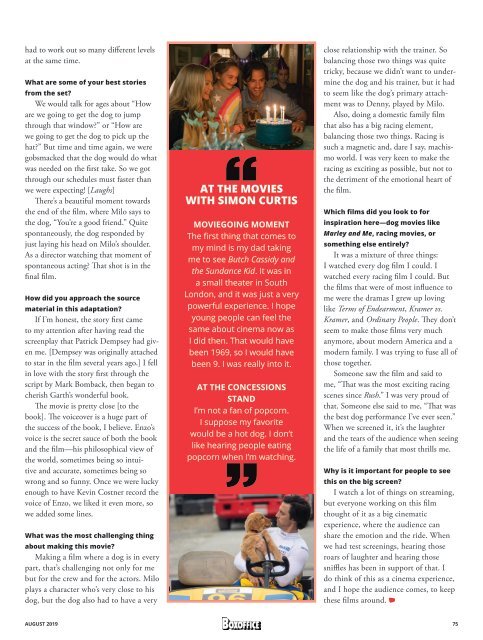Boxoffice - August 2019
The Official Magazine of the National Association of Theatre Owners
The Official Magazine of the National Association of Theatre Owners
You also want an ePaper? Increase the reach of your titles
YUMPU automatically turns print PDFs into web optimized ePapers that Google loves.
had to work out so many different levels<br />
at the same time.<br />
What are some of your best stories<br />
from the set?<br />
We would talk for ages about “How<br />
are we going to get the dog to jump<br />
through that window?” or “How are<br />
we going to get the dog to pick up the<br />
hat?” But time and time again, we were<br />
gobsmacked that the dog would do what<br />
was needed on the first take. So we got<br />
through our schedules must faster than<br />
we were expecting! [Laughs]<br />
There’s a beautiful moment towards<br />
the end of the film, where Milo says to<br />
the dog, “You’re a good friend.” Quite<br />
spontaneously, the dog responded by<br />
just laying his head on Milo’s shoulder.<br />
As a director watching that moment of<br />
spontaneous acting? That shot is in the<br />
final film.<br />
How did you approach the source<br />
material in this adaptation?<br />
If I’m honest, the story first came<br />
to my attention after having read the<br />
screenplay that Patrick Dempsey had given<br />
me. [Dempsey was originally attached<br />
to star in the film several years ago.] I fell<br />
in love with the story first through the<br />
script by Mark Bomback, then began to<br />
cherish Garth’s wonderful book.<br />
The movie is pretty close [to the<br />
book]. The voiceover is a huge part of<br />
the success of the book, I believe. Enzo’s<br />
voice is the secret sauce of both the book<br />
and the film—his philosophical view of<br />
the world, sometimes being so intuitive<br />
and accurate, sometimes being so<br />
wrong and so funny. Once we were lucky<br />
enough to have Kevin Costner record the<br />
voice of Enzo, we liked it even more, so<br />
we added some lines.<br />
What was the most challenging thing<br />
about making this movie?<br />
Making a film where a dog is in every<br />
part, that’s challenging not only for me<br />
but for the crew and for the actors. Milo<br />
plays a character who’s very close to his<br />
dog, but the dog also had to have a very<br />
AT THE MOVIES<br />
WITH SIMON CURTIS<br />
MOVIEGOING MOMENT<br />
The first thing that comes to<br />
my mind is my dad taking<br />
me to see Butch Cassidy and<br />
the Sundance Kid. It was in<br />
a small theater in South<br />
London, and it was just a very<br />
powerful experience. I hope<br />
young people can feel the<br />
same about cinema now as<br />
I did then. That would have<br />
been 1969, so I would have<br />
been 9. I was really into it.<br />
AT THE CONCESSIONS<br />
STAND<br />
I’m not a fan of popcorn.<br />
I suppose my favorite<br />
would be a hot dog. I don’t<br />
like hearing people eating<br />
popcorn when I’m watching.<br />
close relationship with the trainer. So<br />
balancing those two things was quite<br />
tricky, because we didn’t want to undermine<br />
the dog and his trainer, but it had<br />
to seem like the dog’s primary attachment<br />
was to Denny, played by Milo.<br />
Also, doing a domestic family film<br />
that also has a big racing element,<br />
balancing those two things. Racing is<br />
such a magnetic and, dare I say, machismo<br />
world. I was very keen to make the<br />
racing as exciting as possible, but not to<br />
the detriment of the emotional heart of<br />
the film.<br />
Which films did you look to for<br />
inspiration here—dog movies like<br />
Marley and Me, racing movies, or<br />
something else entirely?<br />
It was a mixture of three things:<br />
I watched every dog film I could. I<br />
watched every racing film I could. But<br />
the films that were of most influence to<br />
me were the dramas I grew up loving<br />
like Terms of Endearment, Kramer vs.<br />
Kramer, and Ordinary People. They don’t<br />
seem to make those films very much<br />
anymore, about modern America and a<br />
modern family. I was trying to fuse all of<br />
those together.<br />
Someone saw the film and said to<br />
me, “That was the most exciting racing<br />
scenes since Rush.” I was very proud of<br />
that. Someone else said to me, “That was<br />
the best dog performance I’ve ever seen.”<br />
When we screened it, it’s the laughter<br />
and the tears of the audience when seeing<br />
the life of a family that most thrills me.<br />
Why is it important for people to see<br />
this on the big screen?<br />
I watch a lot of things on streaming,<br />
but everyone working on this film<br />
thought of it as a big cinematic<br />
experience, where the audience can<br />
share the emotion and the ride. When<br />
we had test screenings, hearing those<br />
roars of laughter and hearing those<br />
sniffles has been in support of that. I<br />
do think of this as a cinema experience,<br />
and I hope the audience comes, to keep<br />
these films around.<br />
AUGUST <strong>2019</strong><br />
75

















